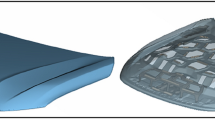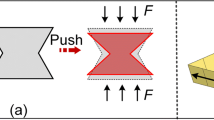Abstract
This study introduces a new method for decreasing the hood stiffness, by making a hole on the inner hood panel. To determine the most effective hole position on the inner hood panel, the method of modal stiffness was employed, in an attempt to reduce the HIC from a collision between a vehicle and a head-form impactor. FRF (frequency response function) results for the reference vehicle model on head-form impact simulation were obtained. In addition, modal analysis of the entire vehicle model was simultaneously carried out. Subsequently, using the results of these two analyses, dominant frequencies (41.7 Hz and 83.3 Hz) were obtained, which related to deformation of the inner hood panel. Then, adequate hole positions at each modal frequency were selected, and the inner hood panel was improved, by making a hole at these positions. Finally, through head-form impact simulations on the improved vehicle model with the hole, it was demonstrated that the new method applied in this study is acceptable and useful. In the case of the improved vehicle model with a 40 mm diameter hole on the inner hood panel, this showed a significant reduction in the HIC of approximately 12.2%, compared to the original vehicle model.
Similar content being viewed by others
Abbreviations
- M:
-
mass
- K:
-
static stiffness
- Kd :
-
dynamic stiffness
- λr :
-
eigenvalue of the r-th mode
- {ü}:
-
acceleration vector
- {φr}:
-
eigenvector of the r-th mode
- {u}:
-
displacement vector
- {F}:
-
force vector
- Δλr :
-
variation of the eigenvalue of the r-th mode
- Δφr :
-
variation of the eigenvector of the r-th mode
- Δ[K]:
-
variation of the stiffness matrix
- ω:
-
frequency of vibration
- ωr :
-
frequency of vibration of the r-th mode
- L:
-
length of the plate
- pi :
-
design variables
- H(ω):
-
compliance; receptance
- X(ω):
-
displacement of the impact point
- F(ω):
-
force acting on the vehicle system
References
Farooq, S. I. and Schuster, P. J., “Body Concept Design for Pedestrian Head Impact,” SAE Technical Paper, no. 2003-01–1300, 2003.
Berg, F. A., Egelhaaf, M., Bakker, J., Brkle, H., Herrmann, R., and Sceerer, J., “Pedestrian Protection in Europe-the Potential of Car Design and Impact Testing,” http://wwwuneceorg/fileadmin/DAM/ trans/doc/2002/wp29grsp/inf-gr-ps-12epdf (Accessed 12 NOV 2015)
Matsui, Y., Ishikawa, H., and Sasaki, A., “Validation of Pedestrian Upper Legform Impact Test-Reconstruction of Pedestrian Accidents,” Proc. of 16th International Technical Conference on Experimental Safety Vehicles, vol. 31, pp. 2152–2167, 1998.
Yao, J. F., Yang, J. K., and Fredriksson, R., “Reconstruction of Head-to-Hood Impact in an Automobile-to-Child-Pedestrian Collision,” International Journal of Crashworthiness, vol. 11, no. 4, pp. 387–395, 2006.
Yoshida, S., Igarashi, N., Takahashi, A., and Imaizumi, I., “Development of a Vehicle Structure with Protective Features for Pedestrians,” SAE Technical Paper, no. 1999-01–0075, 1999.
Barnes, B. M., Brei, D. E., Luntz, J. E., Strom, K., Browne, A. L., and Johnson, N., “Shape Memory Alloy Resetable Spring Lift for Pedestrian Protection,” Proc. of SPIE, vol. 6930, Paper no. 693005, 2008.
Scherf, O., “Development and Performance of Contact Sensors for Active Pedestrian Protection Systems,” http://www-nrdnhtsadotgov/ Pdf/esv/esv19/05–0021-Wpdf (Accessed 12 NOV 2015)
Fredriksson, R., Zhang, L., and Bostrom, O., “Influence of Deployable Hood Systems on Finite Element Modelled Brain Response for Vulnerable Road Users,” International Journal of Vehicle Safety, vol. 4, no. 1, pp. 29–44, 2009.
Shin, M. K., Park, K. T., and Park, G. J., “Design of the Active Hood Lift System using Orthogonal Arrays,” Proceedings of the Institution of Mechanical Engineers, Part D: Journal of Automobile Engineering, vol. 222, no. 5, pp. 705–717, 2008.
Fach, M. and Ockel, D., “Evaluation Methods for the Effectiveness of Active Safety Systems with Respect to Real World Accident Analysis,” http://www-nrdnhtsadotgov/pdf/esv/esv21/09–0311pdf (Accessed 12 NOV 2015)
Kerkeling, C., Schäfer, J., and Thompson, G.-M., “Structural Hood and Hinge Concepts for Pedestrian Protection,” http://www-nrd. nhtsadotgov/pdf/nrd-01/esv/esv19/05–0304-Wpdf (Accessed 12 NOV 2015)
Masoumi, A., Shojaeefard, M. H., and Najibi, A., “Comparison of Steel, Aluminum and Composite Bonnet in Terms of Pedestrian Head Impact,” Safety Science, vol. 49, no. 10, pp. 1371–1380, 2011.
Schwarz, D., Bachem, H., and Opbroek, E., “Comparison of Steel and Aluminium Hood with Same Design in View of Pedestrian Head Impact,” SAE Technical Paper, no. 2004-01–1605, 2004.
Fernholz, K. D., Lazarz, K., and Wang, C., “Preliminary Results from an Experimental Evaluation of the Root Causes of Bond-Line Read-Through,” Proc. of the Adhesion Society 32nd Annual Meeting, pp. 285–287, 2009.
Shin, H.-W., “A Feasibility Study to Replace Steel Made Hood Panels by Magnesium Alloy Made Hood Panels,” Int. J. Precis. Eng. Manuf., vol. 13, no. 11, pp. 2011–2016, 2012.
Searson, D. J., Anderson, R. W., and Hutchinson, T. P., “The Effect of Impact Speed on the HIC Obtained in Pedestrian Headform Tests,” International Journal of Crashworthiness, vol. 17, no. 5, pp. 562–570, 2012.
Untaroiu, C. D., Shin, J., and Crandall, J. R., “A Design Optimization Approach of Vehicle Hood for Pedestrian Protection,” International Journal of Crashworthiness, vol. 12, no. 6, pp. 581–589, 2007.
Stammen, J. A., Saul, R. A., and Ko, B., “Pedestrian Head Impact Testing and Pcds Reconstructions,” Proc. of the 17th International Technical Conference on the Enhanced Safety of Vehicles, no. 326, pp. 1–9, 2001.
Cotoni, V., Langley, R. S., and Shorter, P. J., “A Statistical Energy Analysis Subsystem Formulation using Finite Element and Periodic Structure Theory,” Journal of Sound and Vibration, vol. 318, no. 4, pp. 1077–1108, 2008.
Kassem, M., Soize, C., and Gagliardini, L., “Structural Partitioning of Complex Structures in the Medium-Frequency Range. An Application to an Automotive Vehicle,” Journal of Sound and Vibration, vol. 330, no. 5, pp. 937–946, 2011.
Finnveden, S., “Evaluation of Modal Density and Group Velocity by a Finite Element Method,” Journal of Sound and Vibration, vol. 273, no. 1, pp. 51–75, 2004.
Willinger, R., Baumgartner, D., and Guimberteau, T., “Dynamic Characterization of Motorcycle Helmets: Modelling and Coupling with the Human Head,” Journal of Sound and Vibration, vol. 235, no. 4, pp. 611–625, 2000.
Wilson, K. H., and Carr, D. J., “Head Protection, The Application of Mathematical Modelling,” Proc. of the 1993 International Ircobi Conference on the Biomechanics of Impacts, pp. 325–336, 1993.
Cho, S. W., Kim, S. W., Park, J.-P., Yang, S. W., and Choi, Y., “Engineering Collaboration Framework with Cae Analysis Data,” Int. J. Precis. Eng. Manuf., vol. 12, no. 4, pp. 635–641, 2011.
Shin, H.-W., “A Feasibility Study to Replace Steel Made Hood Panels by Magnesium Alloy Made Hood Panels,” Int. J. Precis. Eng. Manuf., vol. 13, no. 11, pp. 2011–2016, 2012.
Adams, R. D., Cawley, P., Pye, C. J., and Stone, B. J., “A Vibration Technique for Non-Destructively Assessing the Integrity of Structures,” Journal of Mechanical Engineering Science, vol. 20, no. 2, pp. 93–100, 1978.
Cawley, P. and Adams, R., “The Location of Defects in Structures from Measurements of Natural Frequencies,” The Journal of Strain Analysis for Engineering Design, vol. 14, no. 2, pp. 49–57, 1979.
Huynh, D., He, J., and Tran, D., “Damage Location Vector: A Non-Destructive Structural Damage Detection Technique,” Computers & Structures, vol. 83, no. 28, pp. 2353–2367, 2005.
Pandey, A. K., Biswas, M., and Samman, M. M., “Damage Detection from Changes in Curvature Mode Shapes,” Journal of Sound and Vibration, vol. 145, no. 2, pp. 321–332, 1991.
Hong, J. H., Mun, M. S., and Song, S. H., “An Optimum Design Methodology Development using a Statistical Technique for Vehicle Occupant Safety, Proceedings of the Institution of Mechanical Engineers,” Part D: Journal of Automobile Engineering, vol. 215, no. 7, pp. 795–801, 2001.
Author information
Authors and Affiliations
Corresponding author
Rights and permissions
About this article
Cite this article
Min, S., Kim, H., Chae, SW. et al. Design method of a hood structure adopting modal analysis for preventing pedestrian’s head injury. Int. J. Precis. Eng. Manuf. 17, 19–26 (2016). https://doi.org/10.1007/s12541-016-0003-2
Received:
Revised:
Accepted:
Published:
Issue Date:
DOI: https://doi.org/10.1007/s12541-016-0003-2




